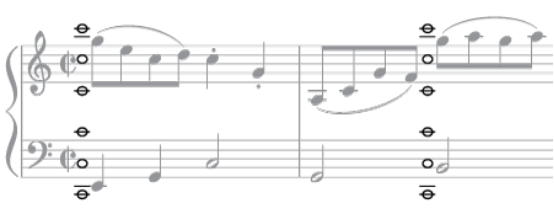
The confounding of notes with the same name in different octaves
Octave disorientation is an affliction that can sometimes bewilder piano teachers. As a fluent note reader, it can be difficult to see how a student could mix up a B beside Middle C with a B way down below Low C. These notes look so clearly different on the staff – how could a student confuse them?
What we need to understand is that the student with octave disorientation is most likely not seeing the grand staff the same way we are: as a map of the keyboard. At this stage in their learning, they do not see the logic behind the music notation system; they only see it as individual notes to be deciphered into letters. They may have memorised note names and learned how to find notes on the keyboard, but they have not really understood the underlying relationships. To cure octave disorientation, therefore, we need to give them a new way to look at the staff.
Symptoms
Prescriptions
C Reorientation
In lesson
The landmark Cs can be a fantastic grounding tool to help students with octave disorientation. You may already use these notes as a method of note reading, but even if you teach using a different note reading method they can still be used for this purpose. The best thing about this prescription is that it’s completely universal and can be applied by your student to any piece of music.
At the start of your student’s music, before the first note, draw the six Cs. These six Cs are often known as: Low C, Bass C, Middle C (one in treble clef and one in bass clef), Treble C and High C. If your student’s music does not have a large note range you may be able to leave out Low C and High C. Do not, however, draw the Cs in only one clef; it’s important that your student sees the symmetry in the grand staff.

Ask your student to find each C in turn on the piano, first from bottom to top, then from top to bottom, and then randomly. Once this drill is completed, ask her for her starting note in the left hand, and to tell you which C that is closest to. Repeat this for the right hand and then allow her to begin playing. If she loses her octave orientation midway through, stop and repeat the ‘C Reorientation’ process, this time asking her to draw the Cs herself.

At home
You can simply leave the Cs drawn on her music to help her orientate herself at home. The six Cs will serve as a reminder that she needs to be extra careful over her octave orientation at that point in the music.
If your student has severe octave disorientation you might ask her to stop at each of those spots to carefully review her Cs and find her position before continuing. You may also want to assign flashcards, apps or worksheets of the landmark Cs if she does not know them well enough.
Sideways Look
In lesson
The ‘Sideways Look’ attempts to tackle your student’s misunderstanding of the staff head-on by literally giving them a new way to see it. This method is best done with the aid of a photocopier or scanner. Your local office supply store should be able to do this for you very cheaply if you do not have access to one.
Enlarge your student’s music so that one bar (meas-ure) is at least the size of half a page or more – in many cases a 400% enlarge setting on the photocopier will work nicely. Copy a few different bars in this way, perhaps three or four places where your student often gets confused about which octave she should play in.
Put one of these bars on the music stand sideways, so that the treble clef is to the right and the bass clef to the left. Discuss with your student how the inventors came up with the grand staff idea by thinking of a keyboard on its side (a white lie). With the keyboard on its side, all the notes on the right of the piano would be up in the air, and the notes on the left would be down on the ground.
After this discussion, draw a note on your photocopied giant bar of music (keeping it on its side) and ask your student to play it on the piano. Do this for several notes and then flip the music back to its regular orientation. Point at random to each note you drew and ask your student to identify them again on the piano. Repeat these steps for each of your other photocopied bars. You may wish to break this exercise up by playing a piece or doing another lesson activity in between each bar, as interleaved practice of any concept is generally more effective and your student will be more engaged.
Repeat the ‘Sideways Look’ at a few subsequent lessons and the relationship of “up” on the grand staff to “right” on the keyboard – and “down” to “left” – will reveal itself to your student. Once she has grasped this internal logic she will never again confound a Low C with a Middle C or a Bass A with a Treble A.
At home
‘Sideways Look’ is best done in the lesson. However, you may wish to assign some other theory work (apps, worksheets, flashcards) that focuses on matching the staff directly to the keyboard as a complement to this exercise. You can then repeat ‘Sideways Look’ in each lesson, choosing different pieces to enlarge until your student’s octave disorientation seems to be cured.
Related Diagnoses
Finger Fascination